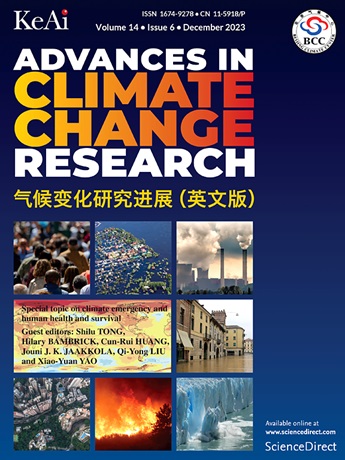Impacts of snow cover on the cooling mechanism and performance in the crushed-rock interlayer embankment
IF 5.2
1区 地球科学
Q1 ENVIRONMENTAL SCIENCES
引用次数: 0
Abstract
Most researches assume snow cover as an unventilated thermal resistance to discuss its impacts on the crushed-rock interlayer embankment (CRIE). However, as a porous medium, its role in altering ventilation cooling remains elusive. We developed a numerical model particularly consisting of ventilated snow cover to investigate impacts on the cooling mechanisms and performance of CRIE under climate change. We found that the cooling performance is seriously underestimated if the ventilation of snow cover is ignored. Natural convection and forced convection coexist in cold seasons, and snow cover is conducive to the former, but not to the latter. Snow cover weakens the cooling performance depending on external wind speeds, ambient temperature and relevant properties of snow cover. Before the limit thickness (about 0.5 m) of snow cover, thermal insulation effect would be enhanced with snow cover thickening. On the contrary, it would be weakened and the cooling role increases relatively after the limit. The same goes for total natural convection strength over the entire period of snow cover. Increased snow cover porosity could enhance the cooling performance, while the increase of external wind speeds and extended duration of snow cover might warm the underlying permafrost. The findings provide a valuable reference for its application in snowy permafrost regions.
积雪对碎石层间路堤冷却机理及性能的影响
大多数研究将积雪作为不通风的热阻来讨论其对碎石层间路堤的影响。然而,作为一种多孔介质,它在改变通风冷却中的作用仍然难以捉摸。我们开发了一个特别包含通风积雪的数值模型,以研究气候变化对cre冷却机制和性能的影响。我们发现,如果忽略积雪的通风,冷却性能将被严重低估。在寒冷季节,自然对流和强迫对流并存,积雪有利于前者,不利于后者。积雪削弱了冷却性能,这取决于外部风速、环境温度和积雪的相关特性。在积雪极限厚度(约0.5 m)之前,随着积雪厚度的增加,保温效果会增强。反之,过了极限后,冷却作用反而会减弱,冷却作用反而会相对增大。整个积雪期的总自然对流强度也是如此。积雪孔隙度的增加可以增强其降温性能,而外部风速的增加和积雪持续时间的延长可能会使下伏多年冻土变暖。研究结果为其在多年冻土区的应用提供了有价值的参考。
本文章由计算机程序翻译,如有差异,请以英文原文为准。
求助全文
约1分钟内获得全文
求助全文
来源期刊

Advances in Climate Change Research
Earth and Planetary Sciences-Atmospheric Science
CiteScore
9.80
自引率
4.10%
发文量
424
审稿时长
107 days
期刊介绍:
Advances in Climate Change Research publishes scientific research and analyses on climate change and the interactions of climate change with society. This journal encompasses basic science and economic, social, and policy research, including studies on mitigation and adaptation to climate change.
Advances in Climate Change Research attempts to promote research in climate change and provide an impetus for the application of research achievements in numerous aspects, such as socioeconomic sustainable development, responses to the adaptation and mitigation of climate change, diplomatic negotiations of climate and environment policies, and the protection and exploitation of natural resources.
 求助内容:
求助内容: 应助结果提醒方式:
应助结果提醒方式:


